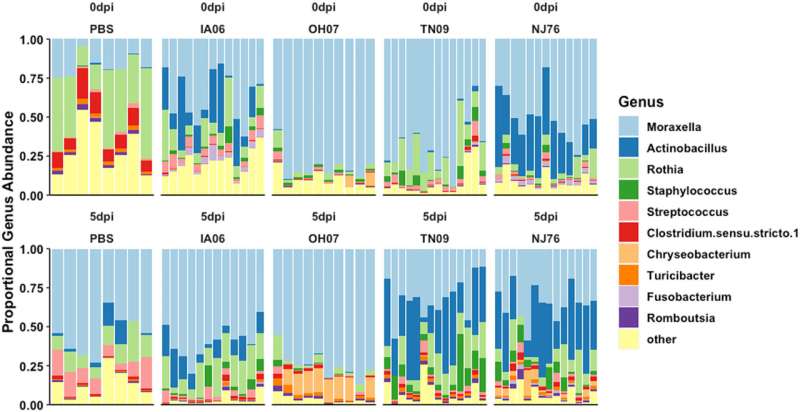This article has been reviewed according to Science X's editorial process and policies. Editors have highlighted the following attributes while ensuring the content's credibility:
fact-checked
trusted source
proofread
Newborn piglets serve as a model for studying influenza

Although prevention and treatment strategies are available for influenza, they are not sufficient for vulnerable populations such as young children and newborns. In a new study published in Virology, a multidisciplinary team of researchers has studied newborn piglets to understand the progression of influenza infections better.
The influenza A virus can infect a variety of birds and mammals, including humans and pigs, due to which it is a threat to public health and food security. While it causes mild to moderate infections in healthy individuals, susceptible human populations are at a higher risk. Even though vaccines and therapeutics are available, they are either less effective or cannot be used in newborns and infants.
"Previous studies have looked at mice models, but compared to mice, pigs are a better model, especially for studying immunity," said Ying Fang (CGD/MMG), a professor of veterinary medicine. "This study is an extension of what we did in the past, where we looked at the effect of maternal immunity on piglets. It is the first study to use neonatal piglet models to elucidate the interactions between the host microbiota and the influenza virus."
The respiratory tract in mammals is home to millions of microorganisms—collectively known as the microbiota. Other research groups have found that the microbiota can dictate an individual's susceptibility to respiratory infections, either by improving immunity or making the infections worse.
To understand the interactions between the virus and the microbiota, the researchers used four types of viruses that differed based on their ability to cause disease. They introduced these virus suspensions drop-by-drop into each nostril of the piglets and monitored them for 5 days to see whether they displayed any symptoms, including changes in body temperature.
The researchers also used nasal swabs to sample the microorganisms that were present at the beginning of the infection and after 5 days.
The team found that certain bacterial species, including Staphylococcus, were associated with the presence of lung lesions, higher rectal temperature, and viral loads, while others, such as Lactobacillus and Megasphaera, had the opposite effect. These results are in agreement with other studies that have shown that Staphylococcus is linked to inflammation and infection in other influenza and COVID-19 models.
"It is possible that microbes are mediating the impact of the virus on the host," said Christopher Gaulke (MME), an assistant professor of pathobiology. "This means that we could potentially prevent some of the damaging impacts of these infections by providing animals or even humans with probiotic microbes that could be protective."
They also found that regardless of what microbes were present on the first day, the infection disrupted the numbers and types of bacteria that were present in the nasal passages.
"These results suggest that by looking at the microbiota, we can predict whether a pig is infected regardless of the infecting virus strain. Although it might not be the best diagnostic tool at the moment because it is relatively expensive, falling costs and improvements in statistical approaches could soon lead to low-cost microbiome-based diagnostics of swine health. It also highlights the possibility that we could use microbiome-based therapeutics to mitigate the impacts of influenza," Gaulke said.
The researchers are now interested in lengthening the duration of the study to observe the long-term changes in the microbial composition.
"In this study, we focused on the acute phase of infection, so we don't know the long-term impact: how long they take to recover the original levels of the microorganisms and whether they recover completely and resemble the uninfected pigs," Fang said.
"We will also need to test whether these results hold in swine farms and whether they can implement anything that we come up with in our experimental barns," Gaulke said. "Down the road, it would be interesting to see if these sorts of changes occur in human infants that are infected with influenza virus."
More information: Fangfeng Yuan et al, A neonatal piglet model reveals interactions between nasal microbiota and influenza A virus pathogenesis, Virology (2024). DOI: 10.1016/j.virol.2024.109996




















